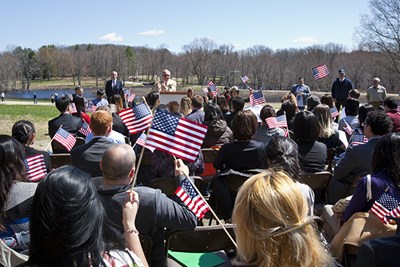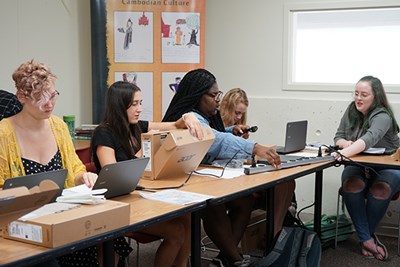College of Education-Park Service Partnership Expands Resources for K-12 Schools
 Image by TIHC
Image by TIHC
03/07/2021
By Katharine Webster
After a year of going almost nowhere because of the COVID-19 pandemic, education major Tiara Williams-Price was excited to go on a class field trip to Lowell National Historical Park – even a virtual one.
She greatly enjoyed the program, Engineering a Better Future, led live over Zoom by teaching staff and rangers from the Tsongas Industrial History Center (TIHC), an educational partnership between the park and UMass Lowell’s College of Education.
“I really enjoyed how interactive it was,” Williams-Price says. “I loved when they put us in breakout rooms and we were trying to figure out a solution to each of the safety problems in the mills. I was in Ranger Frank’s room, and he was really enthusiastic – he made it feel like we were really there at the center with him.”
Williams was helping to beta test the field trip as part of a required, first-year education class, Technology and Digital Literacy in the Classroom. She also helped test another field trip last fall, Mill Girls: Life and Work in an Industrial City.
In a normal year, around 45,000 elementary, middle school and high school students and teachers visit the Tsongas Industrial History Center to learn about history, engineering, immigration, the environment and civics through guided tours of park exhibits and hands-on activities in special classrooms.
When COVID-19 halted those visits in mid-March 2020, staff at the center seized the opportunity to upgrade their technical skills and figure out how to offer virtual experiences that would be engaging while meeting the same, curriculum-based learning objectives, says Kristin Gallas, project manager for education development.
The TIHC team spent most of the spring learning as much as they could about remote education, and then devoted the summer to creating and testing demonstration projects. By late September, the center was piloting its first virtual field trip.
Now that all eight field trips are online, the center is expanding its reach and audience. So far, some schools in New York, New Jersey and North Carolina have participated. All of the field trips can be adapted for different age groups, to meet different curriculum needs.
“I give the staff endless credit for rising to this challenge. It took us a while to understand what teachers want, how they want it, and how we could deliver it,” says Sheila Kirschbaum, director of the center. “Now we’ve got solid coverage of all of the topics they’ve come here for in the past. And we’re getting positive feedback from students and teachers.”
The virtual field trips are conducted using Zoom software, with three staff members working with each class of about 25 students, just as they might during on-site field trips. The programs combine short videos and images with live presentations of park exhibits, reproduction objects and hands-on equipment, to involve the students in doing experiments and solving problems.
On a recent field trip, Change Over Time: Through Children’s Eyes, a class of third-graders from Lowell learned about the residents of the area during three time periods: when the indigenous Penacook lived here, when the descendants of European colonists farmed the banks of the Merrimack River, and at the height of the textile mill era.
The students watched animations and listened to environmental sounds, and then compared them, commenting both live and through the chat function. The staff even had the wiggly 8-year-olds get up and move every few minutes as if they were casting fishing nets, shearing sheep or changing bobbins on a loom.
At the end, the children saw drone footage of what the same area looks like today – their city.
“How do you think life and work changed over time in Lowell?” Interpretation Ranger Resi Polixa asked the class.
“The kids all had to work for the things they wanted,” one child replied.
“Yes – and you get to be in school instead,” Education Ranger MaryBeth Clark said.
 Image by TIHC
Image by TIHC
For the in-person version, students would go into the Water Power classroom and, working in teams, construct canal systems with different types of water wheels and gauges, then run water through them.
For the virtual version, Education Ranger Frank Clark built a canal system live on camera, while asking the students which gauges and water wheels he should use and why. The students were glued to their screens, Carpenter says.
“They used dyed water, which gave a better visual of the water flowing and the mill wheels turning,” she says. “They absolutely made the most of the medium.”
Clinical Prof. Michelle Scribner-MacLean, who teaches Technology and Digital Literacy in the Classroom, says the virtual field trip showed her undergraduate education students how to teach effectively online – and how to keep students engaged, using a variety of digital tools.
The staff “did a wonderful job using photos, artifacts and demonstrations,” she says. “It was like a master class in how to teach remotely.”
Williams-Price agrees. She learned about a brand-new Zoom feature: the annotate function, which allows students to draw, virtually, on the screen. While her class used it to draw safety features on an illustration of a loom, it could be used to demonstrate and solve math problems – or almost anything.
“I’m actually doing student teaching in a few weeks, so I’m definitely going to incorporate the annotate function into my lesson,” she says.




